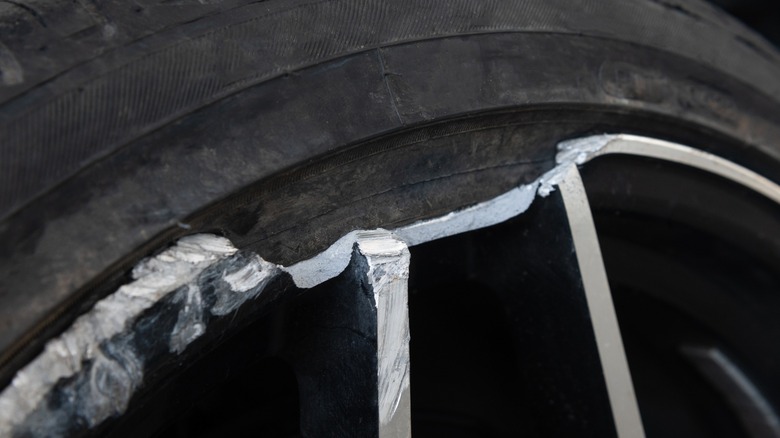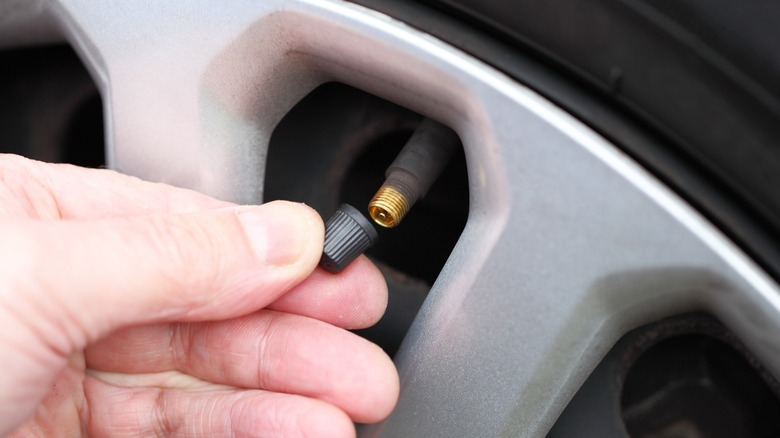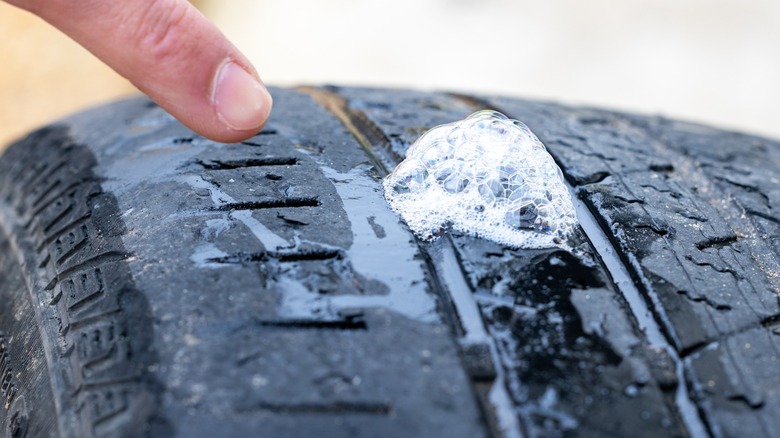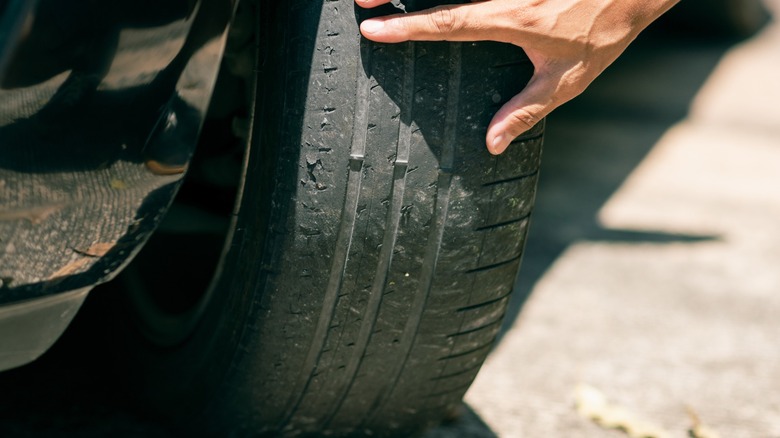How To Identify What's Causing A Slow Leak In Your Car Tires
Tires naturally lose pressure over time due to regular wear and tear. However, if you find yourself needing to pump up every day and the Tire Pressure Monitoring System (TPMS) light is constantly glowing on your dashboard, it's a clear sign of a deeper problem. You might be dealing with a slow leak.
As the name suggests, a slow leak occurs when your tire gradually loses air, leading to a flat or underinflated tire. This is not a problem you should ignore. According to the National Highway Traffic Safety Administration (NHTSA), driving on underinflated tires can be risky. An underinflated tire can mess with your car's balance, making it harder to handle and less comfortable to drive. It wears out the tire faster or unevenly, causes your engine to consume more fuel, and increases the chances of your car tire failing, which can lead to accidents. Essentially, ignoring a slow leak can compromise your safety and that of other drivers.
But how do you know when your tire has a slow leak? The answer is simple—check your tires. Here's a guide for how you can go about it.
Inspect the bead seal and wheel rim
A good place to look when trying to figure out what's causing the slow leak is around the bead seal and wheel rim. If you're familiar with the parts of a car tire, you'll know that the bead seal attaches the tire firmly to the rim of the wheel. It's the area where the tire and wheel rim meet, helping to hold in the tire pressure and keep the tire properly inflated.
However, when there's something wrong with the bead seal or wheel rim, it creates a hole for air to escape. Not in bursts but in gradual seepages. If the bead seal isn't installed properly or there's an accumulation of dirt, it can cause a problem. Additionally, driving roughly and hitting curbs, speed bumps, and potholes can create small gaps or cracks in the rim that allow air to escape.
A crack or dent in the rim may be more obvious when you check for it. But to confirm if the bead seal has tiny tears, apply soapy water around the area. If it bubbles, you've found your leak. Depending on the severity of the damage, you might be able to get it fixed at a service repair shop where an expert would clean or re-fit the tire bid seal to make sure it's snug.
Check the valve stem for any issues
The valve stem is a small but very important part of the tire that consists of the valve stem core and the valve stem cap. Typically, it regulates tire air pressure and controls how air enters or leaves your tires. When you need to inflate your tire, this is the spot where you attach the pump.
A problem with any part of the valve stem can cause a slow leak. If the cap goes missing, the valve stem core becomes vulnerable to dirt and moisture, which can accumulate and deform the valve stem. When the valve stem is deformed, it may crack or become brittle. Over time, it loses its seal and starts to let air seep out slowly. Sometimes, the valve stem core itself can become loose or faulty due to wear and tear, which can also cause a slow leak.
How do you know you have a faulty valve stem? The first noticeable sign is when the rubber looks worn out or the pin has visible cracks. Again, the soapy water method can come in handy. Spray the water mix on the valve stem core while the cap is off, and if it bubbles up, that's a sign you've got a leaking valve.
Replacing a valve stem means you'll have to takef the tire from the wheel. While it's something you can attempt at home if you have the right tools, professionals at an auto shop can get it done for you faster and safer.
Confirm there aren't small punctures on the tire
With a big puncture, you might notice a gash or hear a loud hissing noise when something pierces the tire sharp and hard. However, not all sharp objects make a large, instantly noticeable dent. Items like small rocks, nails, and screws can create tiny holes and lodge themselves in position, causing your tires to slowly lose pressure.
Over time, as you continue to drive, the tire pressure will decrease, and your car's TPMS may alert you. You might not notice the small object at first if you don't look closely enough and might just go ahead and pump the tire. However, you'll continue to struggle with a slow leak until you remove the foreign object.
Depending on the size of the object and the extent of the damage, you might be able to patch the tire. The quickest solution is often a patch and plug. While this is a quick fix, you should still consider how fixable the hole is and how cost-effective patching a tire really is.
Find out how old your tires are
There are tips to make your tires last longer. But the truth is, no matter how well you take care of them, your tires will start to age and wear down over time. As your tires age, they become more likely to have problems. Older tires may start to develop cracks in the sidewalls or tread, and the rubber can become brittle, making it hard to hold air properly. This gradual wear and tear can eventually lead to slow leaks.
To find out how old your tires are, look for the DOT code on the sidewall. This code ends with a four-digit number that shows the week and year the tire was made. For example, a code ending in "2319" means the tire was made in the 23rd week of 2019. Knowing how old your tires are helps you decide if they're ready to be replaced with a new set.
Generally, tires under 5 years old are still in good shape if you've been maintaining them properly, but it's important you still inspect them regularly for any signs of wear and tear. If the tires are between 5 and 10 years old, and even if they look fine, consider replacing them if you see any signs of aging or wear. As for tires over 10 years old, even tire manufacturers, like Michelin, for example, will recommend that you replace them as soon as possible so your car performs well and you're safe on the road.




